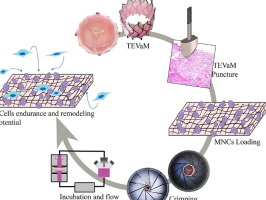Acta Biomaterialia ( IF 9.7 ) Pub Date : 2018-03-02 , DOI: 10.1016/j.actbio.2018.02.029 Agnieszka A. Książek , Laura Frese , Petra E. Dijkman , Bart Sanders , Sarah E. Motta , Benedikt Weber , Simon P. Hoerstrup

|
Data on in vitro engineered “off the shelf” matrices support the concept of endogenous cellular repopulation driving the graft’s remodeling via immune-mediated response. This seems important to further accelerate the cell reconstitution and may play a crucial role when mononuclear cells are used. Nevertheless, studies on decellularized xenogeneic grafts showed only limited host cell repopulation post-implantation.
This study aims at a systematic comparison of reseeding methods (dripping, injection, bathing in a cell suspension and combined puncturing-dripping method) to define the most efficient technique enhancing recellularization of tissue engineered vascular matrices (patches, vessels, small diameter and standard size valves) prior implantation. The constructs were analyzed histologically, biochemically and biomechanically. Various preconditioning treatments (wet, lyophilized and air-dried) combined with reseeding methods demonstrated the highest cell loading efficiency, despite applied crimping and flow stress, of lyophilization followed by puncturing-dripping technique.
This novel seeding method allows for an efficient, time saving graft reseeding that can be used within a one-step cardiovascular clinical intervention.
Statement of significance
The concept of living tissue engineered, self-repairing, autologous cardiovascular replacements, was proposed alternatively to existing synthetic/xenogeneic prostheses. Recent studies in animal models demonstrate faster in vivo recellularization after grafts pre-seeding with cells prior implantation. Pre-seeded cells hold either, the ability to differentiate directionally or attract host cells, crucial for graft integration and remodeling. It is unclear, however, how efficient the pre-loading is and how well cells withstand the flow. The study presents a systematic overview on cell loading techniques of different cardiovascular constructs, tested under static and dynamic conditions. Comparison illustrates a significantly higher efficiency of cells loading in lyophilized tissues punctured before their standard seeding. This technique may beneficially accelerate remodeling of cardiovascular grafts in further in vivo studies.
中文翻译:

冻干组织工程化血管基质的穿刺可提高其细胞再细胞化的效率
数据上体外工程化“现成的”矩阵支持内源细胞再增殖驱动接枝的经由免疫介导的应答重塑的概念。这对于进一步加速细胞重建似乎很重要,并且在使用单核细胞时可能起关键作用。然而,对脱细胞异种移植物的研究表明,植入后仅有限的宿主细胞重新聚集。
这项研究旨在系统比较再播种方法(滴入,注射,在细胞悬液中沐浴和联合穿刺-滴入方法),以确定增强组织工程化血管基质(斑块,血管,小直径和标准尺寸)再细胞化的最有效技术。瓣膜)。对该构建体进行了组织学,生化和生物力学分析。各种预处理(湿法,冻干和风干)与再播种方法相结合,尽管施加了压接和流动应力,但冻干随后采用穿刺滴落技术显示出最高的细胞装载效率。
这种新颖的播种方法可实现高效,省时的移植物再播种,可在一步式心血管临床干预中使用。
重要声明
替代现有的合成/异种假体,提出了活体组织工程化,自我修复,自体心血管替代的概念。动物模型的最新研究表明,体内注射速度更快移植后在植入前先将细胞与细胞一起播种,然后再细胞化。预接种的细胞具有定向分化或吸引宿主细胞的能力,这对于移植物整合和重塑至关重要。然而,尚不清楚预加载的效率如何以及细胞承受流动的能力如何。这项研究提供了在静态和动态条件下测试的不同心血管构建物的细胞加载技术的系统概述。比较显示在标准接种之前被刺穿的冻干组织中细胞装载的效率明显更高。在进一步的体内研究中,该技术可能有益地加速心血管移植物的重塑。



























 京公网安备 11010802027423号
京公网安备 11010802027423号